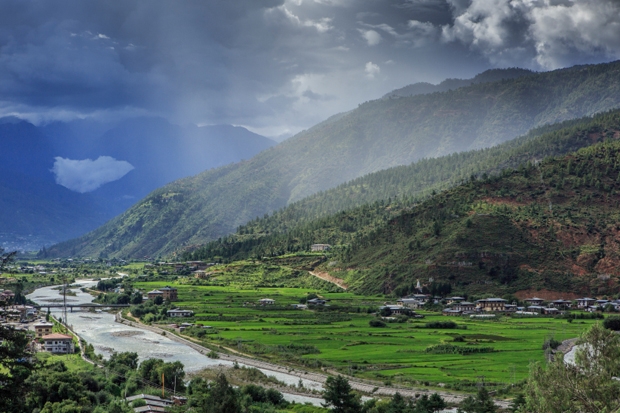There are few more beautiful places in this world than Bhutan in the eastern Himalayas. I know this because, right now, I am staring down the sub-tropical Punakha valley, gazing at an untouched rural landscape where singing women hoe the sunlit chilli fields. It’s glorious. And gloriously devoid of tourists. Though apparently Prince William and Kate are coming here in the next couple of weeks. I hope they don’t lower the tone.
This unusual absence of tourists is down to a government policy. Back in the 1980s (when perhaps two dozen outsiders made it into Bhutan every year) the authorities in the Kingdom of the Thunder Dragon looked at the way tourism was blitzing its way across similar Asian beauties such as Nepal and Thailand, India and the Seychelles, and thought ‘not for us’. They decided to impose a surcharge on all foreign visitors to keep the numbers down and so preserve their culture.
The result of this steep fee — £200 a day simply to be in Bhutan — is that tourism makes barely a dent. Yes, 50,000 people now come every year rather than 15, but more people probably enter your local supermarket every Saturday than cross into Bhutan in a week. And this lack of tourists makes Bhutan very charming indeed.
Of course, this is unique. Surely Bhutan’s policy could never be applied in, say, Europe? Well, hmm. A couple of experiences last year, encountered in my fortunate job as a travel writer, made me wonder whether Bhutan might be an ominous pioneer, not an eccentric outlier.
My first epiphany came in Taormina. I was writing about the glories of western Sicily and the Aeolians, and I was particularly looking forward to Taormina. Loved in its time by Goethe, Wagner, Yeats, Oscar Wilde, D.H. Lawrence, this pearl of Sicily was once described by Ernest Hemingway as being so pretty ‘it hurts to look at it’.
Yet I loathed Taormina. Why? Because as soon as I stepped out of my hotel I was swamped, engulfed, drowned, swept away in a sea of Germans, Americans, Japanese and Brits. The hordes of trippers were so dense that people were literally queueing to get into the town, then queuing to walk down the main street, where they queued to take exactly the same photo. Eventually I gave up queueing to see queues, and nipped into the celebrated Hotel Timeo for a gin and tonic, which cost me £30.
In short: Taormina has been ruined by tourists. And as I sipped my ludicrously overpriced G&T, I realised that this ruination is spreading. And also that this situation cannot go on. We are running out of Europe. We are running out of world.
I’ve seen intolerable touristic overpopulation all over. A couple of years ago it took me two hours to drive five miles into St Tropez in high summer. Hideous. When I go to my native Cornwall it can take me 90 minutes to drive nine miles into St Ives. I’ve seen the same grisly crush in Florence, Capri and Venice, and the prettier villages of Provence, the Costa del Sol, the Algarve.
What’s more, the prospects aren’t brightening, thanks to the two mighty nations that border little Bhutan: China and India.
Right after Sicily I went to the Maldives. There I had some fascinating conversations with hotel managers. They told me they were being flooded with Chinese tourists (and to a lesser extent Russians). So much so, some resorts were using a form of racial filtering: they would allow, say, 30–40 per cent of the resort to be occupied by Chinese, and no more, otherwise the entire hotel would become a Chinese ghetto, and Europeans would refuse to book, changing the nature of the place. The managers were nonetheless very chirpy, because they had 100 per cent occupancy. Booked solid.
A couple of years ago China overtook America and Germany as the nation producing the most foreign tourists. This is because 500 million Chinese have recently been lifted into the middle classes (and hooray for that). And when they begin to use their new disposable income and their passports, what do they do? They all want to go abroad: to the very same destinations, those famous places celebrated in novels, movies and songs. They want to go to London, New York and Paris, they want to see the French Riviera and the sunnier parts of Italy, they want to see palm-fringed beaches of the Caribbean, Tahiti and the Maldives.
And it’s not like the Chinese are the end of it. Soon we’ll see an Indian tourist boom, which means another billion people pouring into Taormina. And why shouldn’t a billion Indians pour into Taormina? They’ve worked hard for their holidays, too.
Should this happen, Taormina would not just be ruined. It would become horrifying, even dangerous. But how do you stop this? It’s possible to make more wine to feed the Chinese lust for claret, but it isn’t possible to manufacture more Provence.
By the end of my autumnal travels, it occurred to me that there is one solution: the Bhutanese example. You ration travel, by time and money: you start to make people pay simply to get into cities, regions, nations. You put walls around towns and close the gates when your country is chocka.
It sounds ridiculous when you put it like that. Tickets to get into coastlines: a Bhutan of Europe. And yet this year, in one particularly lovely part of Italy, the Cinque Terre on the Ligurian coast, they are planning to do exactly that. Such is the yearly crush of visitors to these seaside villages, from cruise ships and bus tours, that they will be limiting the number of summer trippers to 1.5 million (2.5 million came last year). When that figure is reached, that’s it. They will shut the doors, and bar the roads and sea lanes. No one gets in apart from the locals.
What is the logical endpoint of this? Sitting here in Bhutan, I can tell you. We will go back to the past, when the best foreign travel was reserved entirely for the lucky, the wealthy and Prince William. In the future, enjoying a summer holiday in Tuscany might be like having Centre Court tickets for Wimbledon.
So make the most of that next trip to Biarritz or Bermuda, Croatia or Majorca. Because the era of demotic, free-for-all, go-where-you-like travel is coming to an end. The gates will soon be closing, just as they have on the beautiful Punakha valley, where the peasant girls sing their rustic love songs as they pick the rosy apples just in front of my $1,000-a-night five-star hotel.






Comments